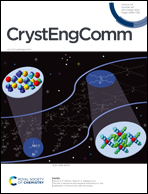Metal–organic framework-derived porous CoFe2O4/carbon composite nanofibers for high-rate lithium storage
Abstract
In this study, porous CoFe2O4/carbon composite nanofibers with metal–organic framework (MOF) structures were prepared by electrospinning and in situ growth followed by annealing. CoFe2O4 particles derived from Prussian blue analogues (PBAs) were firmly anchored onto highly conductive carbon nanofibers by tuning the growth time, generating the sturdy construction and prominent conductivity of CFO@C-24 with a large specific surface area, stable fibrous morphology and MOF structure integrity. Owing to these structural merits, more active sites are provided with accelerated electron/Li-ion transport when the nanofiber is applied as an anode in lithium-ion batteries. A high initial discharge/charge capacity of 1400/1328 mA h g−1 at 0.1 A g−1, a considerable reversible discharge/charge capacity of 623/598 mA h g−1after 400 cycles at 1 A g−1 and an excellent rate performance of 585 mA h g−1 at 1.5 A g−1 are presented. Specific capacities of 1166, 1059, 861, 742 and 585 mA h g−1 of CFO@C-24 are achieved at multiple current densities of 0.1, 0.2, 0.5, 1 and 1.5 A g−1, respectively, and the discharge specific capacity is able to resume to 1035 mA h g−1 when returned to 0.1 A g−1. Upon assembling into full cells, considerable capacitance and rate performance are delivered and a series of LED bulbs can be lit to demonstrate its potential in real applications.



 Please wait while we load your content...
Please wait while we load your content...